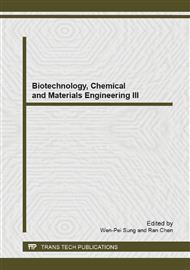p.603
p.607
p.611
p.615
p.619
p.625
p.630
p.634
p.641
Properties of Three Commercial Orthodontic Round Stainless Steel Wire
Abstract:
Objective: This study aimed to determine and compare the diameter, mechanical properties (tensile strength: flexural strength, flexural modulus of elasticity, 0.2% yield strength and springback: three point bending test: bending stiffness and 0.1mm. offset bending force) and chemical properties (composition and corrosion resistance) of three commercial orthodontic round stainless steel wires. Materials and Method: The samples of this study are three commercial brands of orthodontic round stainless steel wires, Highland (USA), Dentaurum (Germany) and W&H (China), 0.016 inch and 0.018 inch in size. The diameter was measured by micrometer and the mechanical properties were analyzed with tensile strength and three point bending test by Universal Testing Machine according to ISO 15841:2006. The composition was evaluated by Energy Dispersive X-ray Spectrometer (EDS) and the corrosion resistance was analyzed by a potentiodynamic polarization technique according to ISO 10271:2001. The data were analyzed with the Kolmoforov-Smith test, One-way ANOVA and Tukeys test. Results: There were significant differences (p<0.05) in diameter of the three commercial brands of orthodontic round stainless steel wires in both size except 0.016 in diameter between Dentaurum and Highland stainless steel wire. In terms of tensile strength, there were significant differences (p<0.05) in the flexural strength, flexural modulus of elasticity and springback in each variable, except W&H stainless steel wire with flexural strength in 0.016 and 0.018 wire size and springback in 0.018 wire size. However, in 0.2% yield strength, there was no significant difference in each brand and size except Dentaurum and Highland stainless steel in 0.018 wire size. For the three point bending test, there were significant differences (p<0.05) in bending stiffness and 0.1mm. offset bending force of each brand and size except 0.1mm. offset bending force between Dentaurum and Highland stainless steel in 0.016 wire size. In terms of chemical properties, there were the same elements but difference was found in percentage of each element, and W&H stainless steel had the least corrosion resistance. Conclusion: There were significant differences among three commercial orthodontic stainless steel wires in diameters, mechanical properties and chemical properties which will produce different force on each wire during tooth movement. All three brands, however, are acceptable for orthodontic use. The orthodontist should be aware of these differences in using stainless steel for orthodontic treatment.
Info:
Periodical:
Pages:
619-624
Citation:
Online since:
January 2014
Keywords:
Price:
Сopyright:
© 2014 Trans Tech Publications Ltd. All Rights Reserved
Share:
Citation:


